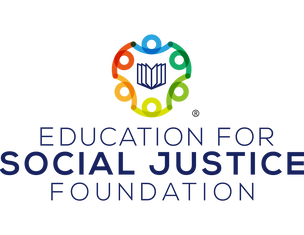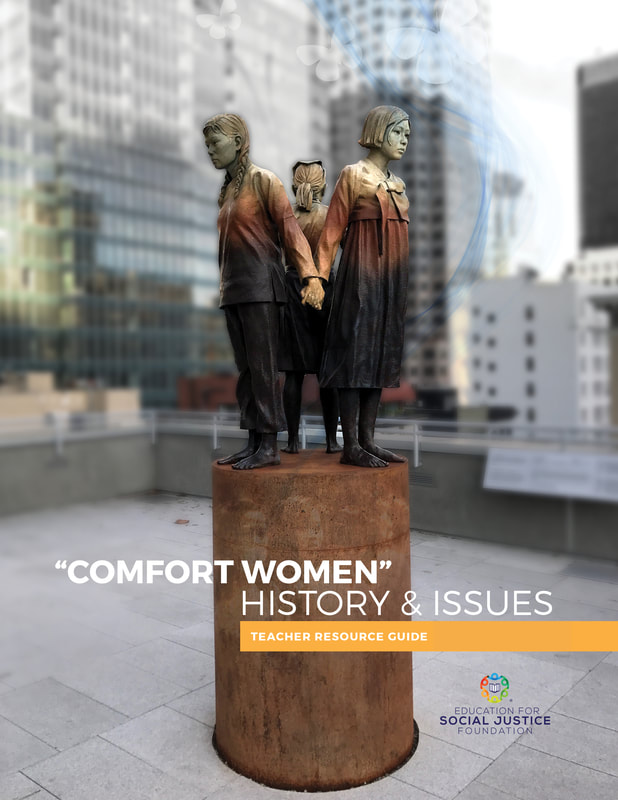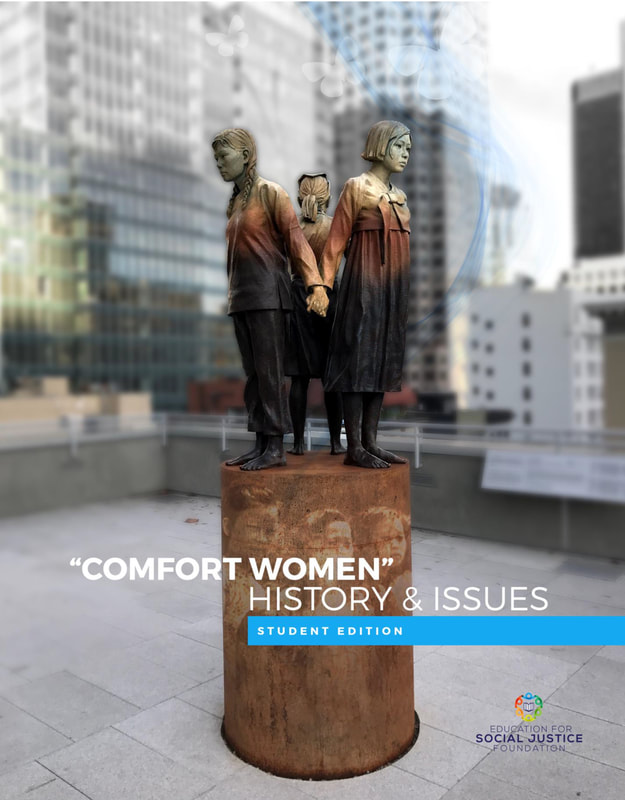“COMFORT WOMEN” HISTORY AND ISSUES
The study of history connects us to our past, enables us to assess the present, and guides us forward; it provides students with the framework and tools needed to understand the world, examine the role each person plays, and decide how they want to have an impact. To instill a more comprehensive understanding of the past, learning about the lives of historically marginalized people is essential. Historical thinking that develops a deeper, broader, and critical view of history can serve to reach this goal. [1] Gaining an inclusive view of history while also getting the opportunity to reexamine their values, knowledge, and approach to thinking will help students appreciate their shared humanity and make responsible, sustainable, and peace-promoting choices for today and tomorrow.
The mission of the Education for Social Justice Foundation (ESJF) is to provide education on past injustices that have been relegated to the sidelines of history. In carrying out our mission, we incorporate lessons learned from the past to develop dignity-affirming and critical-thinking-based curricula, promoting universal values through the history of the marginalized. In this vein, this publication is dedicated to the history of and issues surrounding Japanese military sexual slavery through the lens of the women survivors who courageously spoke out and turned what could have been buried history into a transnational justice-seeking movement. The lessons from this dark past and the empowering legacies of the survivors remind us of the significance of peace and the power of a unified voice to counter sexual and gender-based violence in conflict and non-conflict.
The Japanese military sexual slavery system, established and operated by the Japanese Imperial Armed Forces from the 1930s until the end of World War II, forced hundreds of thousands of women and girls from at least thirteen countries that Japan colonized or occupied in Asia into military sexual slavery (See “Comfort Station” Maps from Appendix A). The massive scale and chillingly methodical nature of the system, along with the mass murder of victims as the military faced defeat, make the Japanese military sexual slavery system one of the most profound instances of human rights violations in history. In 1998, the United Nations Commission on Human Rights defined Japanese military sexual slavery as a crime against humanity.[2] The women and girls forced into this sexual slavery system are referred to as “comfort women.” Although the term “comfort women” ignores the atrocious and inhumane reality of Japanese military sex slaves, because this term was in common use in official documents and studies for decades, this resource guide uses the terms “comfort women” and Japanese military sex slaves interchangeably. The term “comfort women” is enclosed in quotes to indicate its use as a euphemism.
Since the early 1990s, encouraged by the democratization movement that ended military dictatorship and enabled a direct presidential election in South Korea in 1987, Korean survivors of the “comfort women” system broke their silence and have demanded an official apology and reparations from the Japanese government. Together with other supporters, the survivors transformed their grassroots advocacy movement into part of a global movement for women’s human rights, justice, and empowerment.
However, Japan’s official position on the “comfort women” system is far from the views and experiences of the survivors. Instead of formally acknowledging this crime against humanity, the Japanese government misrepresents or denies the history of Japanese military sex slaves. Ignoring that this dark history of state-sanctioned military sexual violence and slavery is about widespread human rights violations against women and girls from low socio-economic status in colonized or occupied countries, some even argue that “comfort women” issues are strictly political issues between Korea and Japan. The absence of state accountability for forcing numerous women and girls into a systemic, state-sanctioned military sexual enslavement during the ’30s and ’40s have rippled outward to other tragedies of sexual and gender-based violence in conflict and non-conflict across history and around the globe.
Aligned with the 2017 California H-SS Framework, this resource guide provides lesson plans and other resources helpful to teaching “comfort women” history. Throughout the resource guide, analytical, critical, and comparative thinking strategies are heavily incorporated, encouraging students to ask questions, think, and rethink. Open-ended questions before and after each sub-section also invite students’ inquiry-thinking skills and further learning. The section Central Themes and Research Topics addresses the devastating impact of Japan’s wartime military sexual slavery on women and girls at the intersection of imperialism, human rights violations, violence, discrimination, and ongoing injustice rooted in distortion and denial of history.
This third edition of “Comfort Women” History and Issues: Teacher Resource Guide is comprised of five main parts:
1) the history of “comfort women” from the perspectives of the survivors along with the local and global women’s human rights movement; its impact on California and SFUSD in education and San Francisco “comfort women” memorial installation;
2) primary source documents with background information;
3) survivors’ testimonies from Korea, China, the Philippines, Indonesia, Japan, and the Netherlands;
4) reflections from a former member of the San Francisco Board of Supervisors, Eric Mar, who proposed a resolution to install a “comfort women” memorial, and from sculptor Steven Whyte, who designed the Women’s Column of Strength memorial, co-written by gallery director, Ellen Wilson;
5) lesson plans, worksheets, and activity sheets.
Lesson plans were developed by Christina Tang, Faye Kwan, Erin Hanlon, and Carrie Seidler, active San Francisco Bay Area high school teachers who are committed to teaching the history of marginalized populations. Parents and educators developed activity sheets to reinforce and integrate learning. These supplemental materials include a back-to-back sheet of quick facts on military sex slaves and a map that can be used as a paper fortune teller origami activity and puzzles. Together with dedicated teachers, parents, and advocates, ESJF first distributed “Comfort Women” History and Issues: Teacher Resource Guide throughout SFUSD high schools in spring 2018.
This resource guide is the culmination of community collaboration. Without the input of other justice-seeking individuals, both here and abroad, it would not have come to fruition. Education has always been a basic building block and pillar for human progress. ESJF hopes that this publication can help students increase their historical and social awareness, standing together for peace and justice.
[1] In National Standards for History (1996), Gary Nash lists five types of historical thinking: chronological thinking; historical comprehension; historical analysis and interpretation; historical research capability; and historical issues-analysis and decision-making.
[2] Gay J. McDougall, Systematic Rape, Sexual Slavery and Slavery-Like Practices During Armed Conflict: Final Report, (UN Sub-Commission on the Promotion and Protection of Human Rights, E/CN.4/Sub.2/1998/13, June 22, 1998), 41.
Submitted by Sung Sohn
The mission of the Education for Social Justice Foundation (ESJF) is to provide education on past injustices that have been relegated to the sidelines of history. In carrying out our mission, we incorporate lessons learned from the past to develop dignity-affirming and critical-thinking-based curricula, promoting universal values through the history of the marginalized. In this vein, this publication is dedicated to the history of and issues surrounding Japanese military sexual slavery through the lens of the women survivors who courageously spoke out and turned what could have been buried history into a transnational justice-seeking movement. The lessons from this dark past and the empowering legacies of the survivors remind us of the significance of peace and the power of a unified voice to counter sexual and gender-based violence in conflict and non-conflict.
The Japanese military sexual slavery system, established and operated by the Japanese Imperial Armed Forces from the 1930s until the end of World War II, forced hundreds of thousands of women and girls from at least thirteen countries that Japan colonized or occupied in Asia into military sexual slavery (See “Comfort Station” Maps from Appendix A). The massive scale and chillingly methodical nature of the system, along with the mass murder of victims as the military faced defeat, make the Japanese military sexual slavery system one of the most profound instances of human rights violations in history. In 1998, the United Nations Commission on Human Rights defined Japanese military sexual slavery as a crime against humanity.[2] The women and girls forced into this sexual slavery system are referred to as “comfort women.” Although the term “comfort women” ignores the atrocious and inhumane reality of Japanese military sex slaves, because this term was in common use in official documents and studies for decades, this resource guide uses the terms “comfort women” and Japanese military sex slaves interchangeably. The term “comfort women” is enclosed in quotes to indicate its use as a euphemism.
Since the early 1990s, encouraged by the democratization movement that ended military dictatorship and enabled a direct presidential election in South Korea in 1987, Korean survivors of the “comfort women” system broke their silence and have demanded an official apology and reparations from the Japanese government. Together with other supporters, the survivors transformed their grassroots advocacy movement into part of a global movement for women’s human rights, justice, and empowerment.
However, Japan’s official position on the “comfort women” system is far from the views and experiences of the survivors. Instead of formally acknowledging this crime against humanity, the Japanese government misrepresents or denies the history of Japanese military sex slaves. Ignoring that this dark history of state-sanctioned military sexual violence and slavery is about widespread human rights violations against women and girls from low socio-economic status in colonized or occupied countries, some even argue that “comfort women” issues are strictly political issues between Korea and Japan. The absence of state accountability for forcing numerous women and girls into a systemic, state-sanctioned military sexual enslavement during the ’30s and ’40s have rippled outward to other tragedies of sexual and gender-based violence in conflict and non-conflict across history and around the globe.
Aligned with the 2017 California H-SS Framework, this resource guide provides lesson plans and other resources helpful to teaching “comfort women” history. Throughout the resource guide, analytical, critical, and comparative thinking strategies are heavily incorporated, encouraging students to ask questions, think, and rethink. Open-ended questions before and after each sub-section also invite students’ inquiry-thinking skills and further learning. The section Central Themes and Research Topics addresses the devastating impact of Japan’s wartime military sexual slavery on women and girls at the intersection of imperialism, human rights violations, violence, discrimination, and ongoing injustice rooted in distortion and denial of history.
This third edition of “Comfort Women” History and Issues: Teacher Resource Guide is comprised of five main parts:
1) the history of “comfort women” from the perspectives of the survivors along with the local and global women’s human rights movement; its impact on California and SFUSD in education and San Francisco “comfort women” memorial installation;
2) primary source documents with background information;
3) survivors’ testimonies from Korea, China, the Philippines, Indonesia, Japan, and the Netherlands;
4) reflections from a former member of the San Francisco Board of Supervisors, Eric Mar, who proposed a resolution to install a “comfort women” memorial, and from sculptor Steven Whyte, who designed the Women’s Column of Strength memorial, co-written by gallery director, Ellen Wilson;
5) lesson plans, worksheets, and activity sheets.
Lesson plans were developed by Christina Tang, Faye Kwan, Erin Hanlon, and Carrie Seidler, active San Francisco Bay Area high school teachers who are committed to teaching the history of marginalized populations. Parents and educators developed activity sheets to reinforce and integrate learning. These supplemental materials include a back-to-back sheet of quick facts on military sex slaves and a map that can be used as a paper fortune teller origami activity and puzzles. Together with dedicated teachers, parents, and advocates, ESJF first distributed “Comfort Women” History and Issues: Teacher Resource Guide throughout SFUSD high schools in spring 2018.
This resource guide is the culmination of community collaboration. Without the input of other justice-seeking individuals, both here and abroad, it would not have come to fruition. Education has always been a basic building block and pillar for human progress. ESJF hopes that this publication can help students increase their historical and social awareness, standing together for peace and justice.
[1] In National Standards for History (1996), Gary Nash lists five types of historical thinking: chronological thinking; historical comprehension; historical analysis and interpretation; historical research capability; and historical issues-analysis and decision-making.
[2] Gay J. McDougall, Systematic Rape, Sexual Slavery and Slavery-Like Practices During Armed Conflict: Final Report, (UN Sub-Commission on the Promotion and Protection of Human Rights, E/CN.4/Sub.2/1998/13, June 22, 1998), 41.
Submitted by Sung Sohn



